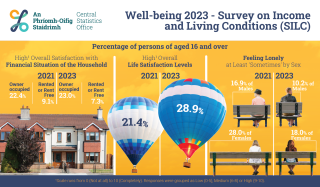Well-being - Survey on Income and Living Conditions (SILC) 2023

The well-being results from the Survey on Income and Living Conditions (SILC) 2023 have been published by the Central Statistics Office. The data covers overall life satisfaction, satisfaction with financial situation of households, loneliness and others across a range of indicators from age to sex to employment status. In the Survey on Income and Living Conditions (SILC) 2023, 28.9 per cent of people aged 16 and over reported a high level of satisfaction with their overall life, up from 24.4 per cent in 2022 and 21.4 per cent in 2021.
Main findings
- In the Survey on Income and Living Conditions (SILC) 2023, 28.9% of people aged 16 and over reported a high level of satisfaction with their overall life, up from 24.4% in 2022 and 21.4% in 2021.
- Almost one in three male (32.1%) respondents reported their overall life satisfaction level as high, compared with one in four (25.9%) female respondents.
- One in ten (10.2%) male respondents reported feeling lonely at least sometimes in the four-week period prior to their SILC interview. The comparable rate for female respondents was almost twice that at 18.0%.
- Just over one in five (21.4%) male respondents reported a low satisfaction level with the time they have available for enjoyable activities, compared with more than one in four (26.6%) female respondents.
- More than four in ten (42.3%) self-employed respondents reported a high satisfaction level with their job. The comparable rate for semi-state employees was 35.4%, 30.7% for public sector employees, and 25.3% for private sector employees.
- Overall, 15.2% of unemployed respondents reported they do not have somebody outside their household they can ask for help. The comparable rate for retirees was 4.2%.
- Almost one in four (23.0%) respondents living in owner-occupied accommodation reported high overall satisfaction with the financial situation of their household. The comparable rate for respondents living in rented accommodation was over three times lower at 7.3%.
Wellbeing indicators by age
Analysis of overall life satisfaction by age shows that in 2023, respondents aged 65 and older were more likely to report high satisfaction with their overall life. More than one in three (35.8%) people aged 65 and older reported high overall life satisfaction compared with one in four (26.7%) people aged 25 to 49 years. Older respondents were also more likely to report high overall satisfaction with the financial situation of their households, with the amount of time they have available for enjoyable activities and with their personal relationships. When it comes to overall satisfaction with the financial situation of their households respondents aged 16-24 having the highest rate for low satisfaction (31.7%) and respondents aged 65 or over having the lowest rate for low overall satisfaction with the financial situation of their household (13.6%). In terms of time available for enjoyable activities, low satisfaction is again is highest for people aged 25-49 with more than three in ten (31.7%) of this age group reporting a low satisfaction level. The low satisfaction rate for persons aged 65 and older is less than one in ten (9.0%). Almost six in ten (58.5%) people aged 65 years and older who described themselves as employed had a high satisfaction level with their job. This was approximately double the rates for people aged 50 to 64 (30.4%) and for people aged 25 to 49 (26.1%).
Wellbeing indicators by sex
Men more likely to report high overall life satisfaction than women in 2023, with almost one in three male (32.1%) respondents and one in four (25.9%) female respondents reported a high satisfaction level with their lives. Female respondents were more likely to report low overall life satisfaction. Women more likely to report low levels of satisfaction with the financial situation of the household with female respondents to the SILC survey were more likely to report low satisfaction levels with the financial situation of their household and less likely to report high satisfaction levels. Almost one in four (24.5%) female respondents reported low satisfaction with the financial satisfaction of their household compared with over one in five (21.5%) male respondents.
Other Wellbeing indicators
Persons in rented accommodation report lower overall life satisfaction. In 2023, respondents living in owner-occupied accommodation were more likely to report a high satisfaction level with their overall lives, with one in three (33.4%) of this group reporting high satisfaction compared with less than one in five (18.1%) respondents living in rented accommodation. Almost one in four (23.0%) respondents living in owner-occupied accommodation reported high overall satisfaction with the financial situation of their household. The comparable rate for respondents living in rented accommodation was over three times lower at 7.3%. Respondents who described their Principal Economic Status (PES) as ‘unemployed’ or ‘unable to work due to long-standing health problems’ reported much lower rates of overall life satisfaction. More than one in three (35.0%) respondents who were unable to work due to long-standing health problems and one in four (28.6%) unemployed respondents reported low satisfaction with their overall lives. The comparable rate for retirees was 5.6%. Almost one in three (32.4%) unemployed respondents said they felt left out compared with just one in ten (11.6%) respondents who described themselves as retired.
Wellbeing – Survey on Income and Living Conditions 2023 is available here.
